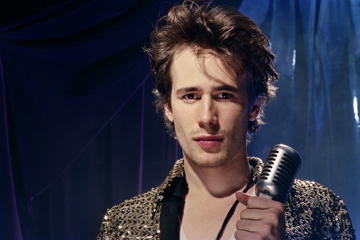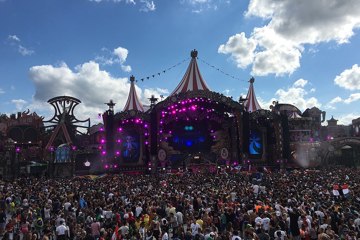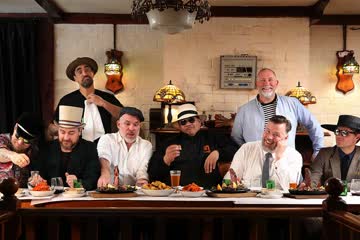Even Kenneth Branagh's Ridiculous Moustache Can't Justify The Existence Of 'Murder On The Orient Express'
We all see that it's a totally different colour to the rest of his hair though, right?
MURDER ON THE ORIENT EXPRESS

When Kenneth Branagh was last behind the camera, on 2015’s Cinderella, it was all about The Dress. Now, with Murder On The Orient Express — where he’s both behind and in front of the camera — it’s all about The Moustache. In bringing back Agatha Christie’s timeless murder-mystery sleuth, Hercule Poirot, for the next generation, Branagh takes to the screen in the most ridiculous false moustache since Dixon Bainbridge, making those whose Movember lip-scruff is barely visible feel particularly inadequate.
And, just in case you think it’s a lark, the production notes for Murder On The Orient Express let you know just how seriously this moustache was taken. Branagh “gathered all written descriptions of Poirot’s moustaches by Agatha Christie”, then undertook a nine-month process of working on the moustache with make-up designer Carol Hemming. “It was Poirot’s superpower,” Branagh says. “It needed to be in itself, structurally and luxuriously pleasing in appearance, and it needed to make a big impression… In a murder mystery with a man like this, the moustache is doing quite a lot of thinking for you”. Well, alrighty then.
Don't miss a beat with our FREE daily newsletter
There’s bountiful moustaches on display in Murder On The Orient Express, with Johnny Depp, Leslie Odom Jr., Josh Gad, and Derek Jacobi all sporting them; and every man, herein, also has a natty hat. The women — Daisy Ridley, Penélope Cruz, Michelle Pfeiffer, Judi Dench, Olivia Colman — come frocked-up, hair-curled and matinee-ready; the film filled with decadent nostalgia for Roaring ’20s glamour, Old Hollywood, and the ’70s revival of Old Hollywood.
The last time Murder On The Orient Express was adapted to silver screen, it was 1974 and, somehow, Sidney Lumet — in between making Serpico and Dog Day Afternoon! — was the director. But the approach is the same, now, as it was then: get a bunch of super-famous actors, stick ’em on the train, and let the super-sleuth sleuth his way to the bottom of this devilish web of best-laid plans, elaborate deceits, and cold-blooded butchery, his moustache, evidently, acting like a bloodhound’s nose, sniffing out truths half-hidden and secrets deeply buried.
The set-up goes like this: in a 1934 in which Ye Olde Travel still carries a whiff of romanticism, exoticism, and adventure, a host of archetypes (The Gangster, The Assistant, The Butler, The Widow, The Missionary, The Professor, The Countess, The Count, The Princess, The Maid, The Governess, The Doctor, etc) board the titular Express, en route from Istanbul through Europe. But, in snowy Yugoslavia, the train is derailed, and Depp turns up murdered in mysterious circumstances. With the locomotive going nowhere, what unfolds is the classic locked-room mystery, in which the culprit must be one of this principal cast.
The film is incredibly stagey, but that suggests its theme of meta-theatre: in which none of the characters are, really, the roles they are playing; whether they are pretending to be someone they’re not, trying to reinvent themselves, playing it cool when passions are high, or, in the case of one character, literally an actress. Sounding out the false notes, for both detective and audience, is akin to a parlour game, something suggested by the production’s essential nature as elaborate act of celebrity dress-ups.
Many will wonder why, in 2017, Poirot is being dusted off for a new generation, with the box-office takings of Murder On The Orient Express what will, inevitably, serve as the barometer for whether this IP-recycling is deemed success or failure. The fact that the film ends with the obligatory lead-in to a hoped-for franchise — “I have to take you to Egypt,” some cockney soldier says to Branagh, “there’s been a murder… on the bloody Nile!” — is a sure symbol of how modern Hollywood works. But Murder On The Orient Express barely does enough to justify its own existence, let alone that of a whole raft more Branagh-in-elaborate-false-moustache movies.
SUBURBICON

It’s fitting that, in a film about segregation, George Clooney’s sixth directorial effort feels like two films divided. At centre is a story from an old Coen Bros script, a satire of All-American ’50s suburbia, White Flight conformity, and Atomic Age aw-shucksery. It’s all, as the familiar depiction goes, just a façade, the brochure-brought-to-life utopia really a dystopia. That’s revealed by Matt Damon’s hapless noir-ish stooge, who sinks into a downward spiral of Fargo-re-do bad choices. There are hired goons, ill-conceived plans, ping-pong-paddlin’ infidelity, an ear for era dialogue, literal white bread, and when Oscar Isaac shows up, lord does this thing sing.
But Clooney and co-producer/script-tweaker Grant Heslov take this Coenist lark and shoot it through with a searing take on what All-American ’50s suburbia represented: segregation, institutionalised racism, cultural whitewashing. Inspired by a real-life tale of persecution in 1957, in the pre-fab commuter-burb Levittown, New York, the flick also finds a black family moving in next door, earning the ire of the Suburbicon-dwellers who fled the city in search of lilywhite conformity. Hoping to drive “these people” outta the there-goes-the-neighbourhood, local yokels harass them day and night, these angry mobs going from hostile gawping to a good old-fashioned race riot, gathering with the wild fury — if not the speed, delirium, or provocation — of the interlopers in Mother! .
This is a fine dramatic premise — especially given that, six decades on, there’s still contemporary social resonance — but one deserving of its own film. Here, searing socio-critique is sidelined, consigned to B-story; our black family (Karimah Westbrook, Leith M. Burke, Tony Espinosa) barely heard from, existing as symbolic figures, not fleshed-out characters. Damon finds his life falling apart — his humiliation symbolising the death of father-knows-best paternalism, he no anti-hero, but villainous patriarchy-incarnate — in black-comic fashion, whilst the horrors of racist persecution sit, uneasily, alongside, the stories of the neighbours remaining separate, on either side of the subdivision fence. The contrast between them makes thematic sense — both stories depict the darkness of suburbia — but not for a coherent picture.
BRAD’S STATUS

“Hey dad, are you having some kind of nervous breakdown or something?” asks Austin Abrams, of his titular father at the end of Brad’s Status. And, while it’s not exactly a nervous breakdown, dear dad (Ben Stiller) has spent the prior 90 minutes — whilst taking his son on a tour of college campuses in Boston — sinking ever deeper into the existential angst of a middle-aged malaise.
A 47-year-old middle-class-white-male’s mid-life crisis is hardly new dramatic territory, but Mike White’s thoughtful, occasionally spiteful drama looks at an age-old deadly-sin, Envy, through the particular insecurities of the digital age.
Status, in the title, refers not just to the social status of Stiller’s beta-male — his life in secondary-market Sacramento, his economy plane-ticket — but to the status updates of the digital era. Wracked by a thousand tiny regrets adding up to a feeling of discontentment, he imagines the lives of his old college pals in sunkissed, slow-mo, veritably heavenly Instagram fantasies: White, a decadent queer director dripping in nouveau riche ridiculousness; Luke Wilson, a super-wealthy hedge-fund titan shepherding trophy wife and tow-headed kids onto private jets; Jemaine Clement, a tech-bro who cashed-out to get stoned and sex it up on Hawaiian beaches; Michael Sheen, a political advisor-turned-talking head and red-carpet walker.
It matters not that these fantasies bear little resemblance to reality; White, instead, situates his drama at that soft spot of toxic insecurity, where the cribbed-from-the-internet sense that other people are doing more with their lives — making more money, having more vacations, taking more selfies — can turn insecurities into feelings of inadequacy. Dramatically, White stages the film as exploration of his central character’s mental state; much of its narrative told through narration, and monologues seething with angst.
This is all familiar terrain for the filmmaker to explore: White wrote not only this year’s haves-vs-have-nots dinner-party lark Beatriz At Dinner, but created television’s great Enlightened, in which Laura Dern’s seemingly new-agey character was full of the caustic anger of the outsider. Brad’s Status follows the thoughts of its titular lead to dark places but, eventually, calls them out: a hot friend of his son’s, Shazi Raja, arrives not only to reawaken Stiller’s dormant desire, but to challenge him on his macho angst and its thinly disguised white-male-privilege. “Don’t ask me to feel bad for you; you’re doing just fine,” she says, as if offering a thematic balm for anyone suffering from social-media insecurity. “Trust me, I promise you, you have enough.”
LOVING VINCENT

Loving Vincent is a production miracle and a narrative mediocrity. Billed as “the world’s first fully painted feature film”, it’s built from 65,000 oil paintings, the combined work of 125 artists. It’s the groundbreaking, kinda-psychedelic dream of Dorota Kobiela, who started out with a dream of marrying her love of painting with her love of animation, which led to a seven-year odyssey to make a film about the life of Vincent van Gogh in which every frame is a van Gogh painting come to (waking) life.
In turn, it’s a wonder to look at, a visual marvel that inspires due awe. Here, even the most rote clichés of a film (credits, titles, typefaces) are made more interesting, and oil-painted takes on photographic devices (dissolves, pullaways, reflections, sunlight hitting lens) are fascinating food for thought. Echoing van Gogh’s wild post-impression, there’s a sense of dynamism in every brush stroke, movement amplified as the images move. Like so many anime films, the most amazing images are of the natural world: rainfall, sunlight on water, drifting clouds, scattered birds, cows and cats.
Yet, for all its glorious imagery, Loving Vincent is limited by its screenplay. Once an audience is accustomed to the wonder of the animation, you’re left with a so-so story; a whodunit-told-in-historical-artworks that could be charitably compared to Peter Greenaway’s Rembrandt’s J’Accuse, and uncharitably compared to a Dan Brown novel. Here, Douglas Booth (or the painted version thereof) plays a man on the case of van Gogh’s death, out to unravel a veritable murder-mystery.
Like a flatfoot charged with all too much legwork, he starts out with a simple errand — deliver an old letter — and ends up retracing van Gogh’s life. Each time he sits down to talk to someone, he leaves with more questions than answers, more places to go. Conversations summon not-so-wildly painted black-and-white flashbacks, in which we get the potted history of a biopic artfully scattered amongst the Rashomon testimonies. We may’ve never before seen a film that looks anything like Loving Vincent, but its story is something far more common.
JUNGLE

If you’ve ever wanted to see Harry Potter pull out a parasitic worm from under the skin of his forehead, Jungle is the film for you (yes, you!). It’s a based-on-a-true-tale yarn of one Israeli chap (Daniel Radcliffe, getting his suffering-for-art on) lost in the Amazon in 1981, and comes billed with the duly thematic tagline: “Nature has only one law: survival”. For director Greg ‘Wolf Creek’ McLean, ‘survival’ naturally begets survival-horror. And, so, Jungle gives us a horror-movie sting — four young men naively head into the wilderness, not all of them will make it out alive — and, eventually, horror-movie tropes, with the forcibly-withdrawn worm feeling more Cronenbergian than Amazonian, and a host of fire-ant bites delivered with the cuts and cues of some Psycho-esque stabbing.
These moments of heightened stylisation — like the various hallucinations, be they mystical mescaline visions, jungle-terror speedfreakin’, or the delusional fantasies of the half-starved and feverish — sit, in many ways, at odds with the film itself. Shot, in part, on location in Colombia, it’s a film in which the titular location should fill an audience with dread; leave us in awe, and fear, of its fearsome power, man made small in the unfeeling vastness of nature. Yet McLean is too restless a filmmaker to let any atmosphere build up, to create a feeling in which the milieu slowly presses in on you. Jungle may burrow deep into the Amazon, but too often all the natural splendour and terror feels like a backdrop to one bro’s various freakouts.
THE ORNITHOLOGIST

The Ornithologist is a much, much, MUCH different lost-in-the-jungle story. Here, Portuguese provocateur João Pedro Rodrigues sends a handsome bird-watcher downriver on a journey into the darkness, filled with surrealist imagery, biblical symbolism, and queerness in both sexuality and aesthetic. Last time Rodrigues was seen on local screens, it was with 2000’s O Fantasma, a film that found infamy — and paying customers — due to its pleasingly graphic depiction of gay sex, and its dark air of shadowy depravity. Here, he taps into the sexiness of heavenly saints and their corporeal bodies, its birdwatcher based on the figure of Saint Anthony of Padua (Portuguese monk-turned-Patron Saint of Lost Things), and stumbling across a hot young thing named Jesus.
There’s likely something particularly Portuguese in all of this — the heavy air of Catholicism, the marginalised Mirandese and their traditional ritual, the juxtaposition of deep religious history with the economically depressed present — but much of it is, likely, lost in translation. For local viewers, it’s a wild ride into the sublime and the ridiculous, a film in which a man heads into the jungle, and strays far from the path of traditional narrative.






